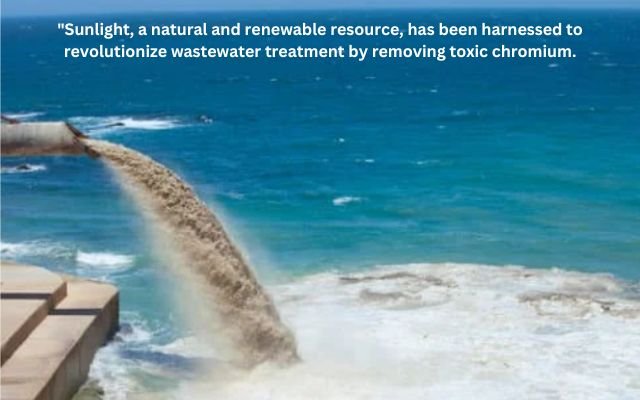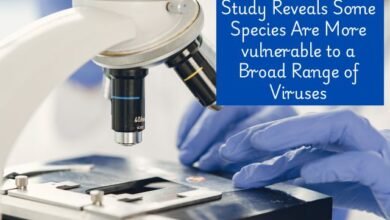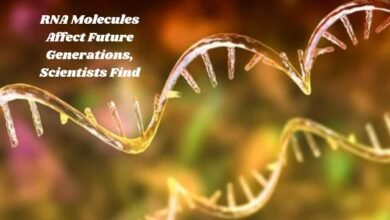Removing Toxic Chromium Using Sunlight: A Game-Changer for Wastewater Treatment
Removing Toxic Chromium Using Sunlight" offers a cost-effective way to reduce pollution in wastewater, ensuring cleaner and safer water for all.

Removing Toxic Chromium Using Sunlight has become a crucial breakthrough in wastewater treatment, addressing the persistent challenge of eliminating harmful substances like hexavalent chromium (Cr(VI)).
In wastewater treatment, dealing with toxic substances like hexavalent chromium (Cr(VI)) has always been a big challenge. This dangerous type of chromium can seriously endanger one’s health and is frequently found in industries like electroplating & leather tanning. World Health Organization (WHO) recommends that wastewater must be treated to remove hexavalent chromium because there is very small acceptable limit of 0.05 mg/L in drinking water.
Traditional methods of removing Cr(VI) from wastewater frequently come with high costs and poor results. Institute of Nano Science and Technology (INST) in Mohali, India, has invented a new technique Removing Toxic Chromium Using Sunlight which offers a viable and affordable alternative.
Challenge of Hexavalent Chromium
When hexavalent chromium is found in drinking water or environment, it is a very hazardous metal that can lead to serious health issues including cancer. This kind of chromium is frequently present in wastewater due to its widespread application in numerous industrial processes. Reducing Cr(VI) to the much safer & less dangerous form of trivalent chromium (Cr(III)) is important for protecting environment & public health.
Adsorption, ion exchange, chemical reduction & bacterial reduction are examples of conventional techniques for removing Cr(VI). These methods have been around for a while but they have lot of disadvantages. They may not be completely effective in purifying water because they are frequently expensive, need sophisticated equipment and have low removal efficiency. This has prompted experts to look for more economical and effective techniques.
Sunlight Powers New Catalyst
Dr. Bhanu Prakash’s research group at INST has developed innovative technique that leverages the power of sunlight in combination with microfluidic technology to remove Cr(VI) from wastewater. This new approach offers a low-cost, efficient solution to a long-standing problem in wastewater treatment.
Researchers at INST named their process continuous flow photoreduction. With this process, the reduction of Cr(VI) to Cr(III) is accelerated by sunlight acting as a catalyst. Adoption of microfluidic technology which enables precise control over the process and improves its efficiency, is the main novelty in this case.
How the Process Works
Making nanocatalysts and microfluidic reactors is first step in the process. Bed of the microreactor is then fitted with these nanocatalysts. Wastewater containing Cr(VI) is run through microreactor after setup is finished.
As wastewater moves through the reactor, it is exposed to sunlight which activates the photocatalyst—titanium dioxide (TiO2) nanoparticles.The less dangerous Cr(III) is produced with the aid of these nanoparticles. Using UV-Vis spectroscopy to measure change in absorbance, success of this conversion is monitored, enabling researchers to see the process unfold in real time.
Flexibility of this approach to increase efficiency is one of its main advantages. Method can be optimized by the researchers by modifying variables including reactor architecture, channel length and wastewater flow rate. For instance- they used a serpentine microreactor coated with a pure anatase phase photocatalyst at a flow rate of 50 µl/min to achieve an amazing 95% degradation efficiency in their tests.
Cost-Effectiveness and Sustainability
This new method’s cost-effectiveness is one of its biggest benefits. Conventional techniques for removing Cr(VI) are frequently costly since they require sophisticated machinery, chemicals and energy-intensive procedures. Approach used by INST researchers, however, is significantly more cost-effective because it makes use of sunshine, a free & renewable energy source.
Furthermore, waste is decreased in addition to increasing process efficiency with application of microfluidic technology. Because microreactors utilized in this technique are reusable, recovery agents or laborious procedures are not required in order to reuse the photocatalyst. Because of this, method is both economical and ecologically benign.
Scalability and Industrial Applications
Chemical Engineering Journal publication of Dr. Prakash’s team’s findings indicates great potential for industrial use. Procedure has proven effective in a lab setting, but the researchers believe it has the potential to be scaled up.
Array technique which involves placing several microfluidic reactors in parallel, is one option to boost process’s throughput. Microtexturing a bulk reactor’s surface is additional option for boosting its effectiveness after repeated use. These tactics might enable technique to be applied on a big industrial scale, providing a workable option for sectors that generate wastewater tainted with chromium.
A Step Towards Cleaner Water
Creation of this effective, low-cost technique to extract hazardous chromium from wastewater is a major advancement in environmental protection. Researchers at INST have developed economical & sustainable solution that not only tackles a serious public health issue but also makes use of microfluidic technology and sunlight.
Innovations like this bring hope for a safer and cleaner future as the world deals with industrial pollution. With more research, this method could be used everywhere, helping industries reduce pollution and making sure everyone has clean, safe water.
- Did a Cosmic Collision Leave a Mark on the Milky Way?
- Scientists Detect Electric Shield Around Earth
- The Future of Plastic: New Living Plastic Biodegradable and Self-Destructive
Conclusion: Removing Toxic Chromium Using Sunlight
The toxic nature of hexavalent chromium in wastewater has been a longstanding concern, particularly for industries that produce large amounts of this pollutant. The innovative method developed by INST researchers represents a breakthrough in wastewater treatment, offering a cost-effective, efficient and environmentally friendly solution.
This technique which makes use of sunlight and microfluidic technology, lowers the toxicity of chromium in a way that is both feasible & scalable for use in industrial settings. This strategy may be extremely important in the future to guarantee that everyone has access to clean water, thereby preserving the environment and public health.access to everyone’s clean, safe water.



